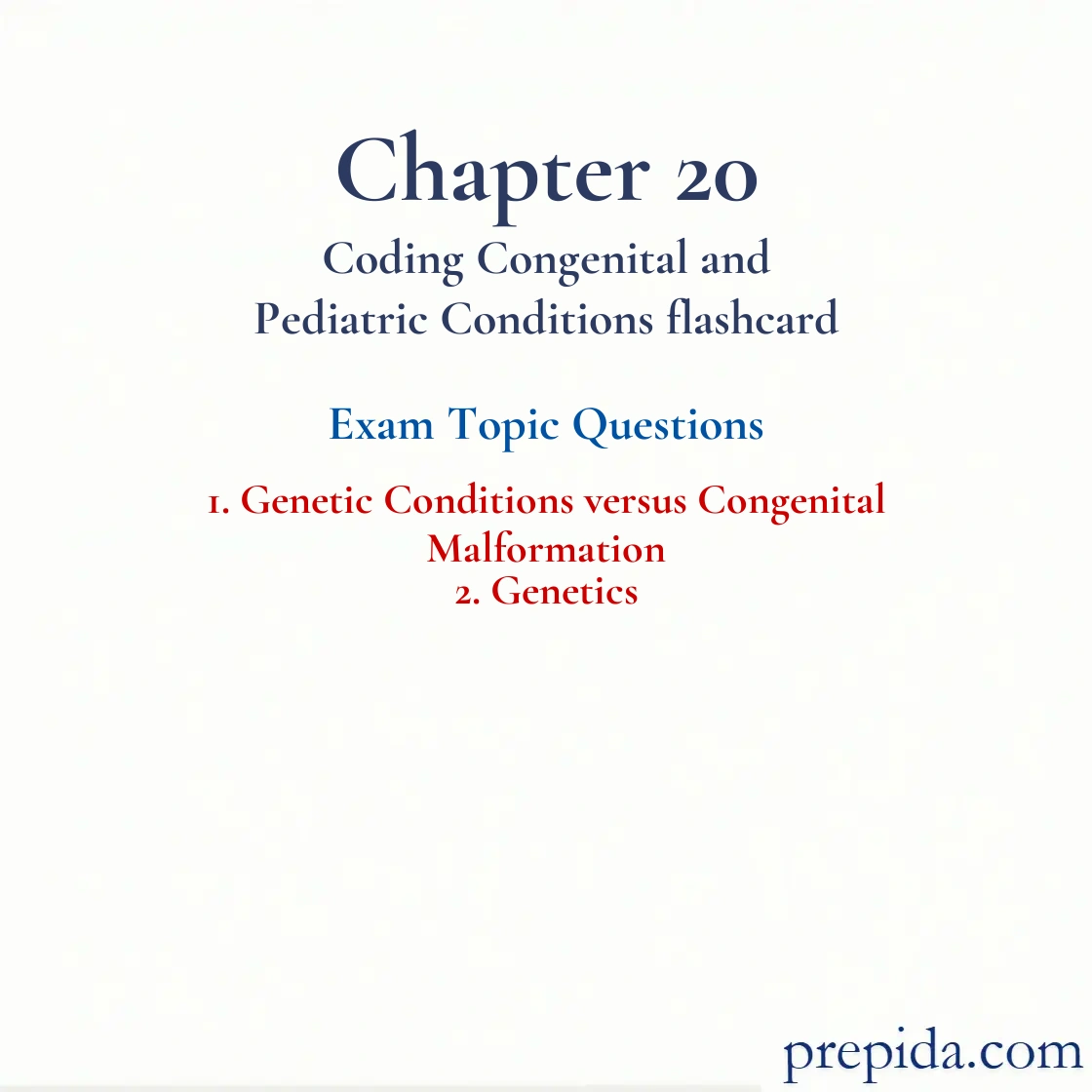
Which of the following terms is used for a condition existing at the time of birth?
- Anomaly
- Congenital
- Malformation
- Preexisting
A congenital condition exists at the time of birth.
Congenital: A condition existing at the time of birth.
Which of the following terms is used to describe an abnormal or unexpected condition?
- Anomaly
- Congenital
- Malformation
- Preexisting
An anomaly is an abnormal or unexpected condition.
Anomaly: Abnormal, or unexpected, condition.
Which of the following describes an irregular structural development?
- Anomaly
- Congenital
- Malformation
- Preexisting
A malformation is an irregular structural development.
Abortion: The expulsion of an embryo or fetus, prior to 20 weeks gestation, from the uterus.
What is the correct code for a patient diagnosed with Goldberg-Maxwell syndrome?
- Q89.9
- Q89.90
- E34.5
- E34.51
The correct code for a patient with Goldberg-Maxwell syndrome is E34.51. E34.51: Index>syndrome>Goldberg-Maxwell.
E Codes: Codes that report how and/or where an injury or poisoning happened.
Which of the following is a blood test?
- Amniocentesis
- Karyotype
- Chorionic villus sampling
- Pedigree
A karyotype is a blood test used to identify inheritance patterns and probabilities.
Anomaly: Abnormal, or unexpected, condition.
Which of the following is used to collect amniotic fluid?
- Amniocentesis
- Karyotype
- Chorionic villus sampling
- Pedigree
An amniocentesis is used to collect amniotic fluid.
Prenatal: Prior to birth; also antenatal.
Which of the following is used to obtain placental tissue samples?
- Amniocentesis
- Karyotype
- Chorionic villus sampling
- Pedigree
Chorionic villus sampling is used to obtain placental tissue samples.
Prenatal: Prior to birth; also antenatal.
Down syndrome is also known as:
- trisomy 12.
- trisomy 13.
- trisomy 18.
- trisomy 21.
Down syndrome is also known as trisomy 21.
Congenital: A condition existing at the time of birth.
Which of the following fetal conditions is not eligible for prenatal repair?
- Closure of neural tube defects
- Cystic fibrosis
- Congenital diaphragmatic hernias
- Spina bifida
Cystic fibrosis is not eligible for prenatal repair.
Condition: A health-related situation.
What is the correct code for a patient with Erdheim syndrome?
- E22.0
- E22.1
- E88.89
- E88.90
The correct code for a patient with Erdheim syndrome is E22.0. E22.0: Index>syndrome>Erdheim.
E Codes: Codes that report how and/or where an injury or poisoning happened.
What is the correct code for a patient with an atrial septal defect?
- Q21.0
- Q21.1
- Q22.0
- Q22.1
The correct code for a patient with an atrial septal defect is Q21.1. Q21.1: Index>defect>atrial septal.
ICD-10-CM: The acronym for International Classification of Diseases, Tenth Revision, Clinical Modification.
Jerika Jones is seen today for Down syndrome. What code is assigned?
- Q90.0
- Q90.1
- Q90.2
- Q90.9
The correct code for a patient with Down syndrome is Q90.9. Q90.9: Index>syndrome>Down.
Sign: Objective evidence of a disease or condition.
A family tree analysis is called a(n):
- amniocentesis.
- karyotype.
- chorionic villus sampling.
- pedigree.
A pedigree is a family tree analysis.
Congenital: A condition existing at the time of birth.
What is the correct code for a patient with congenital aortic septum?
- Q25.1
- Q25.29
- Q25.3
- Q25.40
The correct code for a patient with congenital aortic septum is Q25.40. Q25.40: Index>anomaly>aortic.
Carson Canterbury is seen in the office today. Carson is two years old, and his parents are concerned that he is aging too quickly. The physician orders some tests and diagnoses Carson with progeria. What is the correct code assigned?
- E34.3
- E34.50
- E34.8
- E34.9
The correct code for progeria is E34.8. E34.8: Index>progeria.
Sign: Objective evidence of a disease or condition.